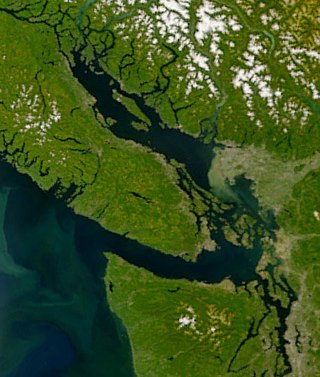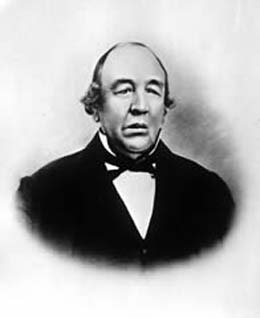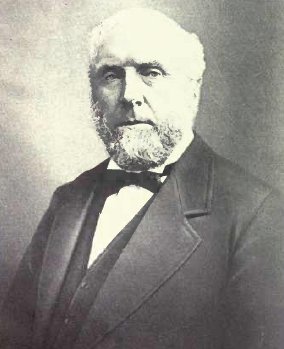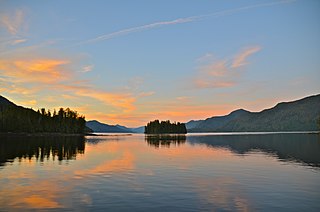
The Strait of Georgia or the Georgia Strait is an arm of the Salish Sea between Vancouver Island and the extreme southwestern mainland coast of British Columbia, Canada, and the extreme northwestern mainland coast of Washington, United States. It is approximately 240 kilometres (150 mi) long and varies in width from 20 to 58 kilometres. Along with the Strait of Juan de Fuca and Puget Sound, it is a constituent part of the Salish Sea.

John Work was a Chief Factor of the Hudson's Bay Company and head of one of the original founding families in Victoria, British Columbia. Work joined the Hudson's Bay Company in 1814 and served in many capacities until his death in 1861, ultimately becoming a member of the company's Board of Management for its Western Department. He also served on Vancouver Island's Legislative Council. At the time of his death, Work was the largest private land owner of Vancouver Island. Work left an important legacy in the form of sixteen journals which chronicle his trading expeditions from 1823 to 1851. His journals provide a detailed record of Pacific Northwest land features, native peoples, and the Hudson's Bay Company's fur trading business in the early 19th century.

Fort Victoria began as a fur trading post of the Hudson’s Bay Company and was the headquarters of HBC operations in the Columbia District, a large fur trading area now part of the province of British Columbia, Canada and the U.S. state of Washington. Construction of Fort Victoria in 1843 highlighted the beginning of a permanent British settlement now known as Victoria, the capital city of British Columbia. The fort itself was demolished in November 1864 as the town continued to grow as a commercial centre serving the local area as well as trading with California, Washington Territory, the United Kingdom, and others.
Loughborough Inlet is one of the lesser principal inlets of the British Columbia Coast. It penetrates the Coast Mountains on the north side of the Discovery Islands archipelago, running about 35 km (22 mi) from its head at the mouth of the Stafford River to Chancellor Channel and Cordero Channel, which are on the north side of West Thurlow Island. A further 14 km (8.7 mi) west along Chancellor Channel is Johnstone Strait.

Saanich Inlet is a body of salt water that lies between the Saanich Peninsula and the Malahat highlands of Vancouver Island, British Columbia, Canada. Located just northwest of Victoria, the inlet is 25 km (16 mi) long, has a surface area of 67 km2 (26 sq mi), and its maximum depth is 226 m (741 ft). It extends from Satellite Channel in the north to Squally Reach and Finlayson Arm in the south. The only major tributary feeding the inlet is the Goldstream River.

Johnstone Strait is a 110 km (68 mi) channel along the north east coast of Vancouver Island in British Columbia, Canada. Opposite the Vancouver Island coast, running north to south, are Hanson Island, West Cracroft Island, the mainland British Columbia Coast, Hardwicke Island, West Thurlow Island and East Thurlow Island. At that point, the strait meets Discovery Passage which connects to Georgia Strait.

The Vancouver Expedition (1791–1795) was a four-and-a-half-year voyage of exploration and diplomacy, commanded by Captain George Vancouver of the Royal Navy. The British expedition circumnavigated the globe and made contact with five continents. The expedition at various times included between two and four vessels, and up to 153 men, all but 6 of whom returned home safely.
William Henry McNeill was best known for his 1830 expedition as the captain of the brig Llama, which sailed from Boston, Massachusetts, United States, 12,000 miles (19,000 km) around Cape Horn, to the Pacific Northwest on a maritime fur trade expedition.

Milbanke Sound is a sound on the coast of the Canadian province of British Columbia.

Roderick Finlayson was a Canadian Hudson's Bay Company officer, farmer, businessman, and politician.
Dowager Island is an island in the North Coast region of British Columbia. To its west is Finlayson Channel, to it east Mathieson Channel. Susan Island lies to its north and Lady Douglas Island to its south. James Johnstone, one of George Vancouver's lieutenants during his 1791-95 expedition, first charted its west and east coasts in 1793. It was named by Captain Daniel Pender during his 1867-70 survey of the region.
Susan Island is an island in the North Coast of British Columbia, Canada. To its west is Finlayson Channel; to its east Mathieson Channel. Roderick Island lies to its north and Dowager Island to its south. James Johnstone, one of George Vancouver's lieutenants during his 1791-95 expedition, first charted its west and east coasts in 1793.

Pooley Island is an island in the North Coast region of British Columbia, Canada. To its west and southwest is Roderick Island, to its east Mathieson Channel. James Johnstone, one of George Vancouver's lieutenants during his 1791-95 expedition, first charted its north and east coasts in 1793. The island was later named after Charles Edward Pooley.

Finlayson Channel is a channel of the British Columbia Coast, Canada. It is a northern extension of Milbanke Sound. To its west are Swindle and Sarah Islands, to its east Roderick, Susan and Dowager Islands. It was first charted in 1793 by James Johnstone, one of George Vancouver's lieutenants during his 1791-95 expedition.

Mathieson Channel is a channel of the British Columbia Coast. It is a northern extension of Milbanke Sound. To its west are Pooley, Roderick, Susan and Dowager Islands, to its east the Don Peninsula. It was first charted in 1793 by James Johnstone, one of George Vancouver's lieutenants during his 1791-95 expedition.
Sarah Island is an island in the North Coast of British Columbia, Canada. It is separated from Princess Royal Island to its west by Tolmie Channel, and from Roderick Island to its east by Finlayson Channel. Its east coast was first charted in 1793 by James Johnstone, one of George Vancouver's lieutenants during his 1791-95 expedition.
Fisher Channel is a channel in the Central Coast region of the Canadian province of British Columbia. To its west are Hunter and Denny Islands, to its east King Island. It was first charted in 1793 by George Vancouver during his 1791-95 expedition. He named it "Fisher’s Channel" after "a much-respected friend" Reverend John Fisher.
James Johnstone was a British naval officer and explorer. He is noted for having served as sailing master of the armed tender HMS Chatham and later acting lieutenant during George Vancouver's 1791–1795 expedition to the Pacific Northwest. Johnstone Strait in British Columbia is named after him.

Mount Tzouhalem is a mountain on Vancouver Island, British Columbia, Canada, 4 kilometres east-northeast of Duncan in the municipality of North Cowichan. It is situated between Quamichan Lake, Maple Bay and Cowichan Bay.

Seaforth Channel is a channel in the Central Coast region of the Canadian province of British Columbia which is part of the Inside Passage - the 950 miles (1,530 km) passage between Seattle, Washington and Juneau, Alaska. The marine highway goes through Seaforth Channel on the way to Milbanke Sound, one of the open sea portions of the Inland Passage. Seaforth Channel which is part of the Prince Rupert/Port Hardy BC ferry route, extends in a westerly direction from Denny Island to Milbanke Sound between Denny Island, Campbell Island and the Wright group of islands on the south. In October 2016, a Texas-owned tug/barge transiting the Canadian waters of the Inside Passage without a local pilot was hard grounded on a reef at the entrance to Seaforth Channel in October 2016. More than 100,000 L of fuel contaminated the coast, coves and shores 20 km (12 mi) west of Bella Bella, the core community of the Heiltsuk Nation as well as the environmentally sensitive Great Bear Rainforest - Canada's contribution to the Queen's Commonwealth Canopy (QCC), a network of forest conservation programs. Clean up response and salvage was criticized by the Heiltsuk, B.C. Premier Christy Clark and Prime Minister Justin Trudeau. In November in Vancouver the Prime Minister announced a $1.5B ocean protection plan to "create a marine safety system, restore marine ecosystems and undertake research into oil spill cleanup methods."













